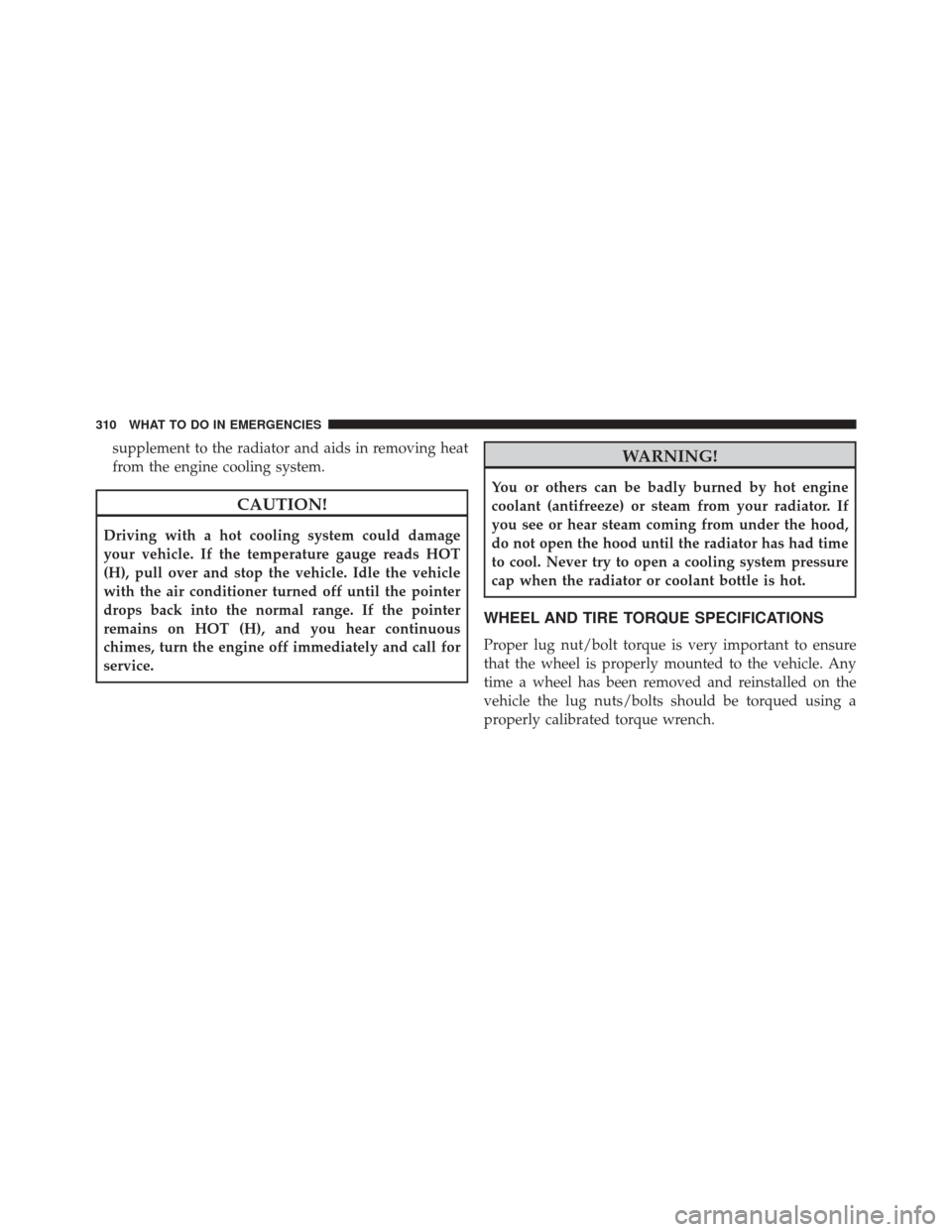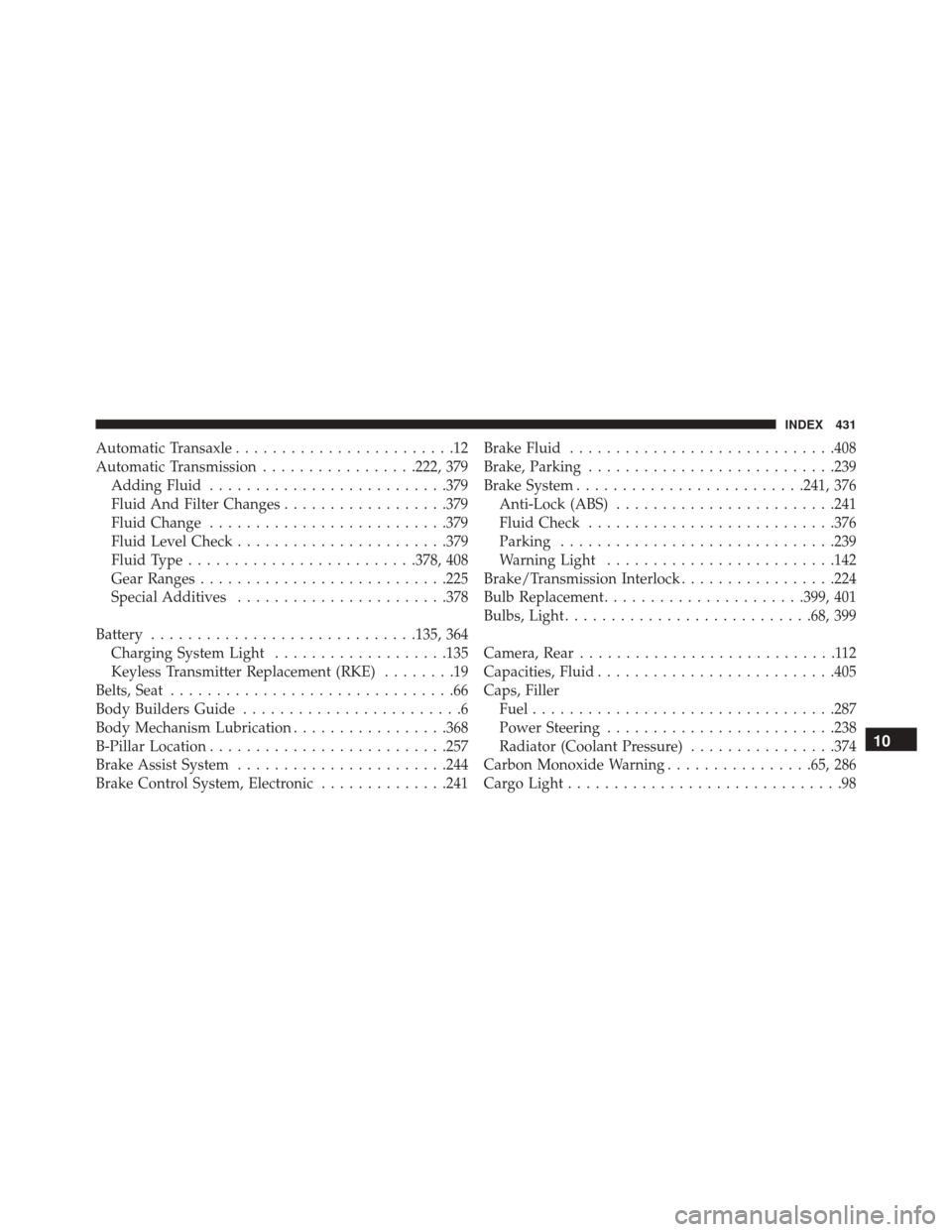2016 Ram ProMaster radiator cap
[x] Cancel search: radiator capPage 312 of 448

supplement to the radiator and aids in removing heat
from the engine cooling system.
CAUTION!
Driving with a hot cooling system could damage
your vehicle. If the temperature gauge reads HOT
(H), pull over and stop the vehicle. Idle the vehicle
with the air conditioner turned off until the pointer
drops back into the normal range. If the pointer
remains on HOT (H), and you hear continuous
chimes, turn the engine off immediately and call for
service.
WARNING!
You or others can be badly burned by hot engine
coolant (antifreeze) or steam from your radiator. If
you see or hear steam coming from under the hood,
do not open the hood until the radiator has had time
to cool. Never try to open a cooling system pressure
cap when the radiator or coolant bottle is hot.
WHEEL AND TIRE TORQUE SPECIFICATIONS
Proper lug nut/bolt torque is very important to ensure
that the wheel is properly mounted to the vehicle. Any
time a wheel has been removed and reinstalled on the
vehicle the lug nuts/bolts should be torqued using a
properly calibrated torque wrench.
310 WHAT TO DO IN EMERGENCIES
Page 372 of 448

The washer fluid reservoir will hold a full gallon of fluid
when the Low Washer Fluid Light illuminates.
WARNING!
Commercially available windshield washer solvents
are flammable. They could ignite and burn you. Care
must be exercised when filling or working around
the washer solution.
After the engine has warmed, operate the defroster for a
few minutes to reduce the possibility of smearing or
freezing the fluid on the cold windshield. MOPAR All
Weather Windshield Washer Solution or equivalent, used
with water as directed on the container, aids cleaning
action, reduces the freezing point to avoid line clogging,
and is not harmful to paint or trim.
Cooling System
WARNING!
• When working near the radiator cooling fan, dis-
connect the fan motor lead or turn the ignition
switch to the OFF position. The fan is temperature
controlled and can start at anytime the ignition
switch is in the ON position.
• You or others can be badly burned by hot engine
coolant (antifreeze) or steam from your radiator. If
you see or hear steam coming from under the hood,
do not open the hood until the radiator has had
time to cool. Never try to open a cooling system
pressure cap when the radiator is hot.
370 MAINTAINING YOUR VEHICLE
Page 376 of 448

Cooling System Pressure Cap
The cap must be fully tightened to prevent loss of engine
coolant (antifreeze), and to ensure that engine coolant
(antifreeze) will return to the radiator from the coolant
recovery tank.
The cap should be inspected and cleaned if there is any
accumulation of foreign material on the sealing surfaces.
WARNING!
•Do not open hot engine cooling system. Never add
engine coolant (antifreeze) when the engine is
overheated. Do not loosen or remove the cap to cool
an overheated engine. Heat causes pressure to
build up in the cooling system. To prevent scalding
or injury, do not remove the pressure cap while the
system is hot or under pressure.
(Continued)
WARNING! (Continued)
•Do not use a pressure cap other than the one
specified for your vehicle. Personal injury or en-
gine damage may result.
Disposal Of Used Engine Coolant
Used ethylene glycol-based engine coolant (antifreeze) is
a regulated substance requiring proper disposal. Check
with your local authorities to determine the disposal
rules for your community. To prevent ingestion by ani-
mals or children, do not store ethylene glycol-based
engine coolant in open containers or allow it to remain in
puddles on the ground. If ingested by a child or pet, seek
emergency assistance immediately. Clean up any ground
spills immediately.
374 MAINTAINING YOUR VEHICLE
Page 378 of 448

•Keep the front of the radiator clean. If your vehicle is
equipped with air conditioning, keep the front of the
condenser clean.
• Do not change the thermostat for Summer or Winter
operation. If replacement is ever necessary, install
ONLY the correct type thermostat. Other designs may
result in unsatisfactory engine coolant (antifreeze)
performance, poor gas mileage, and increased emis-
sions.
Brake System
In order to assure brake system performance, all brake
system components should be inspected periodically.
Refer to the “Maintenance Schedule” for the proper
maintenance intervals.
WARNING!
Riding the brakes can lead to brake failure and
possibly a collision. Driving with your foot resting or
riding on the brake pedal can result in abnormally
high brake temperatures, excessive lining wear, and
possible brake damage. You would not have your full
braking capacity in an emergency.
Master Cylinder — Brake Fluid Level Check
The fluid level in the master cylinder should be checked
when performing underhood services, or immediately if
the “Brake System Warning Light” indicates system
failure.
Clean the top of the master cylinder area before removing
the cap. Add fluid to bring the level up to the top of the
“FULL” mark on the side of the master cylinder reservoir.
376 MAINTAINING YOUR VEHICLE
Page 433 of 448

Automatic Transaxle........................12
Automatic Transmission .................222, 379
Adding Fluid ......................... .379
Fluid And Filter Changes ..................379
Fluid Change ......................... .379
Fluid Level Check ...................... .379
Fluid Type ........................ .378, 408
Gear Ranges .......................... .225
Special Additives ...................... .378
Battery ............................ .135, 364
Charging System Light ...................135
Keyless Transmitter Replacement (RKE) ........19
Belts, Seat ...............................66
Body Builders Guide ........................6
Body Mechanism Lubrication .................368
B-Pillar Location ......................... .257
Brake Assist System ...................... .244
Brake Control System, Electronic ..............241Brake Fluid
............................ .408
Brake, Parking .......................... .239
Brake System ........................ .241, 376
Anti-Lock (ABS) ....................... .241
Fluid Check .......................... .376
Parking ............................. .239
Warning Light ........................ .142
Brake/Transmission Interlock .................224
Bulb Replacement ..................... .399, 401
Bulbs, Light .......................... .68, 399
Camera, Rear ............................112
Capacities, Fluid ......................... .405
Caps, Filler Fuel ................................ .287
Power Steering ........................ .238
Radiator (Coolant Pressure) ................374
Carbon Monoxide Warning ................65, 286
Cargo Light ..............................98
10
INDEX 431
Page 434 of 448

Car Washes............................ .381
Cellular Phone .......................... .203
Certification Label ........................ .289
Chains, Tire ............................ .274
Chart, Tire Sizing ........................ .252
Check Engine Light (Malfunction Indicator Light) . .355
Checking Your Vehicle For Safety ...............64
Checks, Safety ............................64
Child Restraint ............................54
Child Restraints Booster Seats ...........................59
Child Restraints .........................54
Infants And Child Restraints ................57
Older Children And Child Restraints ..........57
Cigar Lighter ........................... .121
Clean Air Gasoline ....................... .283
Climate Control ......................... .204
Manual ............................. .204
Cold Weather Operation ....................221 Compact Disc (CD) Maintenance
..............202
Compact Spare Tire ....................... .269
Console, Overhead ........................116
Contract, Service ......................... .422
Coolant Pressure Cap (Radiator Cap) ...........374
Cooling System .......................... .370
Adding Coolant (Antifreeze) ...............372
Coolant Capacity ...................... .405
Coolant Level ..................... .371, 375
Disposal Of Used Coolant .................374
Drain, Flush, And Refill ...................371
Inspection ........................... .375
Points To Remember .....................375
Pressure Cap ......................... .374
Radiator Cap ......................... .374
Selection Of Coolant (Antifreeze) ......371, 405, 406
Corrosion Protection ...................... .380
Cruise Light ......................... .159, 160
Cupholders ......................... .122, 386
432 INDEX
Page 442 of 448

Radiator Cap (Coolant Pressure Cap)...........374
Radio Frequency General Information ...................15, 20
Radio Operation ......................... .203
Rear Camera .............................112
Rear ParkSense System .....................107
Rearview Mirrors ..........................72
Recorder, Event Data .......................53
Recreational Towing ...................... .305
Reformulated Gasoline .....................283
Refrigerant ............................. .366
Reminder, Seat Belt .........................26
Remote Sound System (Radio) Controls .........202
Replacement Bulbs ....................... .399
Replacement Keys .........................15
Replacement Parts ........................ .357
Replacement Tires ........................ .273
Reporting Safety Defects ....................423
Restraint, Head ...........................87 Restraints, Child
...........................54
Restraints, Occupant ........................24
Rotation, Tires .......................... .276
Safety Checks Inside Vehicle ..................66
Safety Checks Outside Vehicle .................68
Safety Defects, Reporting ....................423
Safety, Exhaust Gas .........................65
Safety Information, Tire .....................251
Safety Tips ...............................64
Schedule, Maintenance .....................410
Seat Belt Adjustable Upper Shoulder Belt Anchorage ......33
Automatic Locking Retractor (ALR) ...........36
Energy Management Feature ................36
Lap/Shoulder Belt Operation ................30
Lap/Shoulder Belts .......................28
Lap/Shoulder Belt Untwisting ...............32
Pregnant Women ........................35
440 INDEX